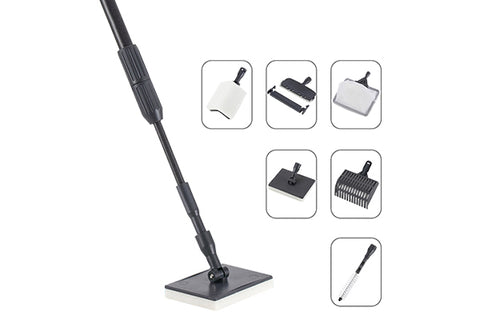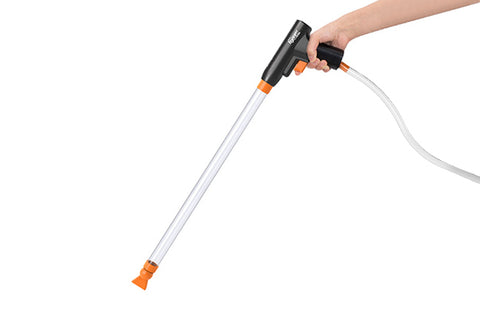Nitrate is a by-product of nitrite oxidation in the nitrogen cycle's later phases, and it's found in all aquariums to some extent. Increased nitrate levels are caused by detritus, decomposing plant material, filthy filters, overfeeding, and overstocking the aquarium.
In nature, nitrate levels in water are very low, usually less than 5 parts per million. Nitrate levels in freshwater aquariums should be kept below 50 parts per million at all times, preferably below 25 parts per million. Keep nitrate levels further lower, below 10 ppm, if you're breeding fish or fighting algal growth.
So how to measure nitrate? What’s its effect on fish? And most importantly how to lower the nitrate in a fish tank?
Measuring nitrate
You will first need to determine what the nitrate level is in your aquarium by testing the tank water with a water test kit. Follow the directions in the kit, and by matching the color of the test with the included color chart, you will know how much nitrate is in the water.
Effect on fish
When nitrate levels in aquariums reach dangerously high levels, fish become lethargic and may have open sores or red spots on their skin.
Fish housed at high levels frequently die unexpectedly, and when a new fish is introduced to an aquarium where the fish have progressively become accustomed to high nitrate concentrations, the new fish often succumbs to the shock.
How to fix high nitrate in an aquarium?
The bacteria that remove nitrate avoid oxygen-rich conditions, unlike the aerobic bacteria that convert ammonia to nitrite and ultimately nitrite to nitrate. As a result, typical filters that are well-oxygenated will not host the bacteria that remove nitrate.
However, here are some guidelines that can help you keep nitrate low:
1. Keep the aquarium clean
The waste eventually forms nitrate. Cleaner tanks produce less nitrate, which requires water changes to eliminate. It can also be educational and teach responsibility, and studies show that viewing an aquarium can be therapeutic as it lowers blood pressure, reduces stress and has a calming effect on people. An aquarium makes a great focal point and gathering place in the home and provides a fun activity for the whole family.
2. Avoid overfeeding
Overfeeding is the number-one cause of high nitrate levels in aquariums. Overfed fish produce much more waste than normal, and when more food is given than they can take in, the uneaten food rots and produces even more waste that is high on phosphate and other nitrate catalysts.
3. Do regular water changes
The overall nitrate level in the aquarium will be reduced by doing regular water changes using water that contains little or no nitrate.
When making a water change, if your local tap or well water is high in nitrate, using deionized water (DI) or reverse osmosis water (RO) can assist maintain nitrate levels low.
However, because these are devoid of minerals, the hardness, alkalinity, and pH of the water may become too low, necessitating the use of mineral supplements. Mix your nitrate-containing tap water with DI or RO water to make a blend with the correct water parameters.
4. Keep live plants
Plants naturally utilize nitrate as a nutrient and food. This is why persistently high nitrate usually results in an algae outbreak and green aquarium water problems. An abundance of nitrate is fuel for the explosive growth of existing algae cells.

5. Use nitrate solutions
Nitrate-adsorbing filter media and anaerobic denitrifying biofilters will remove dissolved nitrate. Now, before you roll up your sleeves and dive right into a thorough cleaning of your aquarium, remember that going from polluted water to fresh, clean water can be just as harmful to your fish as the nitrates themselves. The change in the water chemistry can be a physical shock to your fish. So, if you have a very high nitrate level, start slowly.
How to prevent high nitrate
Now we will provide you with actionable steps divided into daily and weekly maintenance tips that you can follow to prevent high nitrate:
Daily maintenance
- Don't overfeed your fish. Make sure they complete their meal in under two minutes. Rather than feeding your fish a huge amount of food once a day, feed them smaller amounts 2 or 3 times throughout the day.
- Make sure your aquarium isn't too crowded. If you have a high nitrate level despite careful feeding, you probably have too many fish for your setup.
- Perform a short inspection. Remove any decomposition sources, such as stale food, dead fish or invertebrates, and dead or dying plant leaves and stems.
Weekly maintenance
1. Perform regular water changes- The minimum schedule should be weekly, but more is often better! Large changes of 50% or more are much more effective at keeping wastes sufficiently diluted.
- Sometimes tap water contains levels of nitrate that are unacceptable for the aquarium. If that is the case, you either need to use a water purifier such as a reverse-osmosis unit, or you’ll have to buy suitable water for your aquarium.
- Such large changes are not generally possible with a marine tank, though they work very well. This is why saltwater hobbyists often rely on nitrate-reducing systems like live rock and deep sand beds, and it is why reef aquarists usually keep only a few small fish that are lightly fed to minimize waste production.
2. Check your filters regularly
- If you do not have a dedicated bio-filter and rely on the bacterial colonies in your mechanical filter medium, replace only part of the medium at each cleaning.
- If the medium is seriously matted and plugged, a gentle cleaning in a bucket of tank water will remove most of the decomposing gunk without damaging the bio-filter. In fact, it will increase bio-filtration capacity because of the increased flow of oxygen-rich water through the medium.





Comments (0)
Back to Aquarium Maintenance